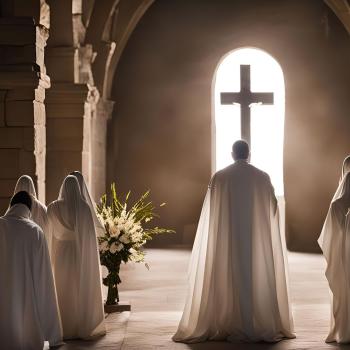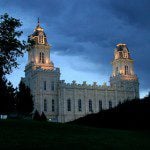Fascinating Topographical and Biblical Factors Closely Examined

This is a fascinating question to ponder. Most Christians likely think that the location and identity of this mountain is certain: that there is a Mt. Sinai in the Sinai Peninsula and that’s that! In fact, everyone admits that it’s not absolutely certain. 7,497 feet high Jebel Musa (or Jabal Musa or Gebel Musa: “Mount Moses”) is the leading candidate. The Catholic Encyclopedia (“Sinai”) states:
[T]he precise location is uncertain. It is Jabal Musa, according to a tradition traceable back to the fourth century, when St. Silvia of Aquitaine was there. . . . However, the difficulty of applying Exodus 19:12 [“. . . Take heed that you do not go up into the mountain or touch the border of it; whoever touches the mountain shall be put to death;”: RSV], to Jabal Musa and the inscriptions found near Jabal Serbal have led some to favour Serbal. This was the opinion of St. Jerome . . .
Sinai was the refuge of many Christian anchorites during the third-century persecutions of the Church. There are traces of a fourth-century monastery near Mount Serbal. In 527 the Emperor Justinian built the famous convent of Mt. Sinai on the north foot of Jabal Mûsa, which has been known since the ninth century as St. Catherine’s.
Archaeologist and evangelical Protestant James K. Hoffmeier, Ancient Israel in Sinai: The Evidence for the Authenticity of the Wilderness Tradition (New York, Oxford: Oxford University Press, 2005), devotes a long chapter (pp. 111-148) to the question. He holds that “no one today can be certain of its location” (p. 114) and that it “has never been identified with certainty” (p. 115).
Likewise, Egyptologist and also an evangelical Protestant, Kenneth A. Kitchen, On the Reliability of the Old Testament, Grand Rapids and Cambridge: William B. Eerdmans Publishing Company, 2003) — probably the greatest living biblical “maximalist” archaeologist — concurs: “In short, certainty is not attainable” (p. 270). Thus, it’s not a matter of liberal, hostile skepticism, but rather, a true uncertainty. But everyone can make their arguments for the plausibility of a particular mountain (as I will myself, below).
Some scholars have argued for an Arabian [ancient Midian] or ancient Edom [present-day Jordan] location, or one in the north or central regions of the Sinai Peninsula, but the vast majority opt for one of several mountains in the south of the peninsula.
Hoffmeier and Kitchen provide several involved geographical and biblical arguments (not easily summarized) for why this is preferable, and Kitchen concluded: “there are no compelling grounds to move ‘Mount Sinai’ into Midian proper or anywhere else in northwest Arabia” (p. 274), while Hoffmeier observed: “never does the Bible explicitly situate Mt. Sinai in Edom, nor is Sinai ever used in parallelism with Midian to suggest the two are synonymous” (p. 129), and: “never does the Bible place Mt. Sinai / Horeb in Midian” (p. 148).
One of the more interesting non-biblical reasons for a southern Sinai location is the “ecological” argument. Hoffmeier observed:
[T]he mountainous region of the south is ecologically favorable for a larger group of people to have lived for eleven months . . . Greater quantities of water . . . are available in the south . . . the water runs off [the granite mountains] into wadis, collects in pools, and can be dammed up. (p. 142)
Other recent research concerning Bedouin orchards in the area: some of which are in the same place as Byzantine farms, showed great ability to produce food:
[A] wadi orchard covering only 600 square feet with fifty-one trees produced 1,623 pounds (738 kilograms) of fruit per season. The fruits included grapes, almonds, apples, pears, apricots, pomegranates, figs, plums, quinces, and peaches.. . .
[S]outh Sinai’s geography and climate best lent itself to the Israelite sojourn at Mt. Sinai described in Exodus 20-Numbers 10. (Hoffmeier, ibid., 142-143)
Moreover, Hoffmeier explains that “Horeb” appears 17 times in the Old Testament (see the instances in RSV). Only three of these (Ex 3:1; 33:6; Dt 1:6) refer to it as a mountain; the other 14, as a region. He adds that “The term Sinai is applied to a wilderness (midbar), and mount (har) Sinai occurs sixteen times . . .” (p. 114; see the 35 OT RSV instances). From this he deduces that “the sacred mountain is located within Horeb” (p. 115). Holman Bible Dictionary (“Mount Sinai”) agrees: “it seems best to think of Horeb as the general term for the area and Sinai as the specific peak where God manifested Himself to Moses.”
If we narrow down the options in this region, it basically comes down to Jebel Musa and two other possible choices: Gebel Safsafeh (aka Ras es-Safsafeh or Willow Peak) and Gebel Serbal. Holman Bible Dictionary (same article) states:
Jebel Musa (7500 ft.) is one of three granite peaks near the southern tip of the peninsula. The highest peak, Jebel Katarin (Mount Catherine, 8,652 ft.), lies immediately on the southwest, and Ras es-Safsafeh (6,540 ft.) on the north, northeast of Jebel Musa. Many explorers think Ras es-Safsafeh is the biblical Sinai because it has a plain, er Rahah , on its northwest base, which is two miles long and about two thirds of a mile wide. This plain was certainly large enough to accommodate the camp of the Israelites.
Jebel Musa and Ras es-Safsafeh sit at opposite ends of a three-mile long ridge: the former on the southern end and the latter to the north. Gebel Serbal is about 2o miles west of the other two mountains in the same range. The Wikipedia page states:
At 2,070 metres (6,791 ft) high, it is the fifth highest mountain in Egypt. . . . There were many granite dwellings on Mount Serbal which were inhabited by anchorites in early Christian times, and there are traces of a fourth-century monastery close to its base. It is likely that the many inscriptions (some in Greek) found on rocks at the foot of Mount Serbal and the path up to its peak date from these times.
Hoffmeier writes about it:
[I]t . . . fits within the general parameters provided by the wilderness itineraries and the eleven-day journey of Deuteronomy 1:2. Furthermore, it is suitable on ecological grounds.. Thus I maintain that there is no reason for excluding it from consideration. Furthermore, it is quite isolated from the surrounding mountain range and has areas for the Israelite encampment. (p. 147)
Hoffmeier thus narrows down the viable choices to three (one being Gebel / Jebel Musa):
Gebel Safsafeh and Gebel Serbal (despite some problems) are viable candidates. Proposed mountains in ancient Midian (Arabia) . . . do not fit the distances or the geographic and toponymic data. (p. 148)
Kitchen also allows three plausible choices, but in the end opts for the superiority of Gebel Musa: considered in conjunction with Gebel Safsafa (aka Safsafeh):
[B]oth Gebel Serbal and the Gebel Musa complex (i.e., Gebel Musa proper and its side-ridge Gebel Safsafa, plus Gebel Katrin/Gebel ed-Deir) would each have serious claims to being the Mount Sinai/Horeb of the exodus narrative, and both have been vigorously championed from Byzantine times to the present. . . .
Both stand up grandly in their places . . . Gebel Serbal is close by the oasis of Feiran, but has no adjacent plain for assembly like that of er-Raha at the very foot of Gebel Musa. . . . Most of the reasons advanced between Serbal and Musa are captious and inconclusive, and so need not be discussed further. In practical terms, the immediate conjunction of clear space plus impressive mountain at Gebel Musa suits the biblical narrative much better than does Gebel Serbal; the latter’s peaks are almost four miles from the wadi bed of Feiran, the only clear “parking space” there for a group of Hebrews, be it 200, 2,000, 20,000, or even more. Having poor old Moses tramping four miles back and forth up side wadis and up a peak of Gebel Serbal is rather extreme . . . (Kitchen, ibid., 269-270)
Wikipedia (“Mount Sinai [Bible]”) notes:
The traditional Mount Sinai, located in the Sinai Peninsula, is actually the name of a collection of peaks, sometimes referred to as the Holy Mountain peaks, which consist of Jabal Musa, Mount Catherine and Ras Sufsafeh. Etheria (circa 4th century CE) wrote, “The whole mountain group looks as if it were a single peak, but, as you enter the group, [you see that] there are more than one.”
The New Bible Dictionary (first edition, 1962, “Mount Sinai”: 1193-94) rules out Gebel Serbal on the basis of the lack of space at its base, and distinguishes between the other two (giving both their “due”):
The location of this mountain is uncertain . . . Tradition and most of the modern scholars accept Gebel Musa as Mt. Sinai. There is, none the less, a strong preference among certain scholars for Ras es-safsafeh as the mountain of the covenant because of the considerable plain at its foot. . . . However, tradition in favor of Gebel Musa is so ancient (c. 1,500 years) and the granite formations so imposing that it is probably Mt. Sinai.
The website Adventist Discovery Centre raises a very interesting biblical consideration:
Some scholars have rejected Jebel Musa as being the real Mount Sinai on the grounds that there is no suitable place at the foot of the mount where a large number of people could camp within sight of the summit. The Bible record seems to require this when it says: ‘On the third day the LORD will come down upon Mount Sinai in the sight of all the people’ (Exodus 19:11, NKJV).
These scholars prefer a granite ridge called Ras es Safsafeh, at the foot of which is a plain which could accommodate a large number of people.
See the similar verse: “Now the appearance of the glory of the LORD was like a devouring fire on the top of the mountain in the sight of the people of Israel” (Exodus 24:17, RSV)
This is now three Bible passages, where the topographical nature of Ras es-Safsafeh appears to fit the text of the Bible better than Jebel Musa:
1) The top of it can’t be seen from the plain, as the Bible requires (Ex 19:11; 24:17).
2) It has an indistinct border at its base, making it difficult to determine where it begins, so as to not be killed for touching it: as a matter of ritual impurity (Ex 19:12).
3) The er-Rahah plain is adjacent to Ras es Safsafeh, not Gebel Musa. The Bible states that “Israel camped there in front of the mountain” (Ex 19:2, NRSV; cf. NIV, NASB, Moffatt, REB, Confraternity, NAB, Goodspeed: “in front of”; Amplified: “at the base of”; Knox: “in full view of”; NEB: “opposite the mountain”).
Hence, Ellicott’s Commentary for English Readers comments on Exodus 19:12:
Moses was required to “set bounds to the people,” i.e., to make a substantial fence between the camp and the base of Sinai, which should prevent both animals and men from coming in contact with the mountain. Modern travellers generally observe how abruptly the rocky precipice of Ras Sufsafeh rises from the plain in front of it, so that in many places it is quite possible to stand on the plain and yet touch the mountain.
The first of the three factors above led Hoffmeier to seemingly express preference for Ras es Safsafeh as Mt. Sinai:
The summit of Gebel Musa is actually not visible from the valley below, where St. Catherine’s Monastery is located, nor can it be seen from er-Rahah plain, thought by many to be the campsite of the Israelites. . . . [E]r-Rahah plain begins at the northwestern side of Ras Safsafah . . .
It is not surprising, then, that many early explorers reacted with skepticism, even disappointment, when first encountering Gebel Musa. [Edward] Robinson admits: “My first and predominant feeling while upon this summit, was that of disappointment. . . .” [Arthur Penrhyn] Stanley also demurred at the tradition of equating Mt. Sinai with Gebel Musa, and declared, . . . [that it] “fails to meet the most pressing requirements of the narrative . . . the mountain never descends upon the plain . . . I am sure that if the monks of Justinian had fixed the traditional scene on the Ras Sasafeh, no one would for an instant have doubted that this only could be the spot.”
The Reverend D. A. Randall, who traveled the Holy Lands in 1862, was likewise impressed with er-Rahah plain and Ras Safsafeh, stating, “The bold and frowning front of Horeb was directly before us, rising up from the plain in an almost perpendicular wall from two to three thousand feet into the air. The site was grand and majestic beyond description.” . . . [see his entire book online]
Associated with the Palestine Exploration Fund, E. H. Palmer spent nearly two months in 1868-1869 exploring this area. He rightly saw that Gebel Musa was rather isolated behind this large range, and could not even be seen from er-Rahah plain. . . . In the spring of 1882, Dr. Henry Fields traveled to southern Sinai. . . . He climbed Ras-Safsafeh and was immediately converted. He said: “when I reached the summit and looked down into the plain of Er-Rahah, I saw the conditions were met, and no longer doubted that I was standing on the holy mount.” (Hoffmeier, ibid., p. 145)
Wikipedia (“Mount Sinai [Bible]”) adds:
[Edward] Hull . . . stated he had no further doubts after studying the great amphitheater leading to the base of the granite cliff of Ras Sufsafeh, that here indeed was the location of the camp and the mount from which the laws of God was delivered to the encampment of Israelites below.
Hoffmeier then recounts his own concurring experiences:
Clearly there is no suitably sized wadi or plain adjacent to Gebel Musa to fit this description [of Ex 19:2]. This factor troubled me the three times I have stood atop Gebel Musa and studied the surroundings. I do, however, resonate with the reaction of these nineteenth-century explorers when viewing Ras-Safsafeh from er-Rahah plain. It is a spectacular sight, and the association between the plain and the mountain makes Gebel Safsafeh a plausible candidate for the biblical Mt. Sinai. (p. 146).
I agree (not that my opinion counts for anything)! These three arguments considered together clinch it for me. The Bible has proven that it is accurate time and again, and it suggests one choice for the peak of Mt. Sinai (i.e., one peak as opposed to a range of several mountains), as far as I am concerned.
***
Photo credit: Saint Catherine’s Monastery, Sinai Peninsula, Egypt, with Willow Peak (Ras-Safsafeh) behind [Wikimedia Commons / Creative Commons Attribution 3.0 Unported license]
***
Summary: The mountain known as Gebel / Jebel Musa is commonly regarded as the biblical Mt. Sinai, but I chronicle what I think is compelling evidence in favor of Willow Peak (Ras-Safsafeh).
















